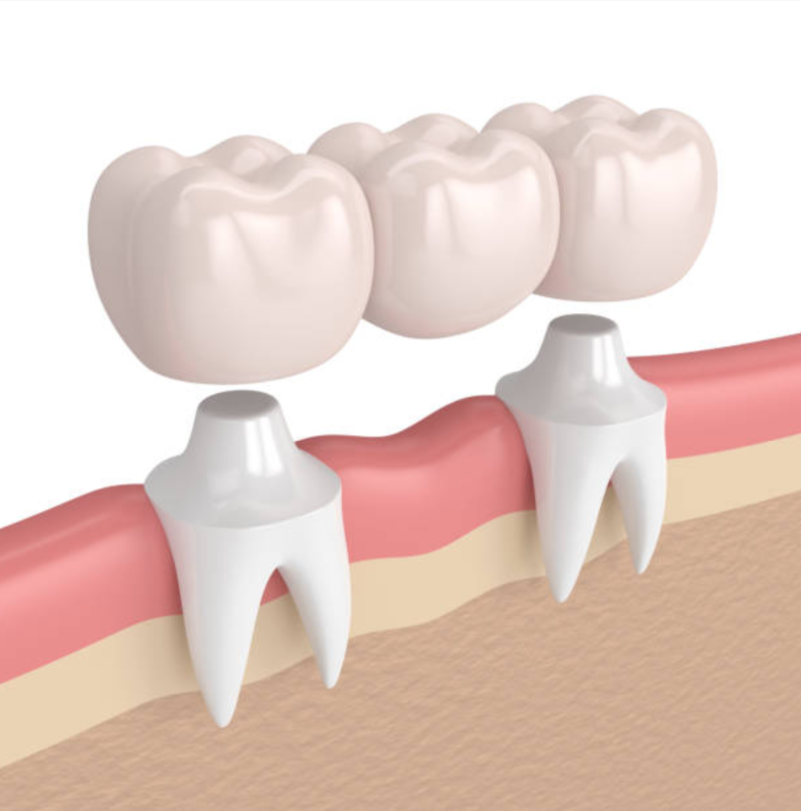What are dental bridges?
A dental bridge is a term to describe a restoration that fills a gap from one or more missing teeth. This restoration requires at least two teeth to be fitted with a dental crown (called abutments), and one or two false teeth (called a pontic) in between the crowns. The materials that make up a bridge can include gold, alloys, porcelain, or a combination of materials. The main purpose for installing dental bridges is for naturally aesthetic functionality.
What types of dental bridges are available?
There are three main types of dental bridges:
Traditional bridges are the most common type of dental bridge and usually consist of porcelain fused to metal or ceramic materials. Traditional bridges use the teeth on either side of the gap as anchors to create balance and stability.
Cantilever bridges are less common than traditional bridges. Dentists don’t typically recommend them for the back of the mouth. These bridges only use one tooth as an anchor when someone cannot have a second abutment. This could be because there is not enough space in the mouth, or one of the adjacent teeth isn’t strong or doesn’t have enough healthy tooth structure. Having only one abutment on the bridge can cause it to be weaker, and too much force can break it.
Maryland bonded bridges can consist of porcelain, porcelain fused to metal, or plastic teeth and gums supported by a metal or porcelain framework. The metal or porcelain attachment is bonded to the back side of the adjacent teeth. This allows for a more aesthetic appeal and doesn’t require nearly as much tooth structure from neighboring teeth as a traditional bridge requires, however this type of bridge also isn’t as strong as a tradition bridge.
Implant-supported dental bridges are like traditional bridges except the opposing crown or crowns are implants. This procedure takes longer to install than any other type of bridge and requires a surgical implant. It takes much longer to heal after the procedure, but it is a great option for patients that have multiple missing teeth.
Why do I need a bridge?
A dental bridge serves many benefits. Individuals will consider a dental bridge to address the following:
- Restoring a natural look to a person’s mouth/smile
- Restoring the ability to speak and chew normally
- Preventing bone loss in the jaw where the missing tooth is
- Maintaining the shape of your face
- Re-adjusting your bite
- Preventing your remaining teeth shifting or tipping where the missing tooth is

How long do dental bridges last?
The longevity of a dental bridge has many factors such as the initial condition of the abutment teeth, location of the bridge in the mouth, and the patient’s oral habits. Smoking, chewing ice, and having poor oral hygiene are examples of habits that may shorten the life of a bridge. However, with good oral health and habits it is possible for a dental bridge to last over 10 years.

Did you know?
How can I ensure a long-life for my bridge?
Having good oral hygiene is crucial to keeping the teeth under a dental bridge healthy. It is important to brush your teeth twice a day and to floss. Debris can get stuck under the bridge where the pontic is, which can cause gum disease and tooth decay. Your dentist and dental hygienist will educate you on proper ways to brush and floss a dental bridge. In addition, going to dental checkups regularly will help you maintain good dental health for your bridge.
What is the process like?
Getting a dental bridge is like getting a crown, except it involves more teeth. It usually requires two visits. At the first appointment, the dentist will prep the teeth by removing some of the tooth structure to allow for a crown to be placed over it like a hat. Next, the dentist and dental assistant work together to take impressions of the teeth. These impressions are used to make a model from which the bridge can be made by a dental lab. The patient will be placed in a temporary bridge until the lab fabricates the bridge (this usually takes two weeks). At the second appointment, the dentist will remove the temporary bridge and cement the permanent one into place.
